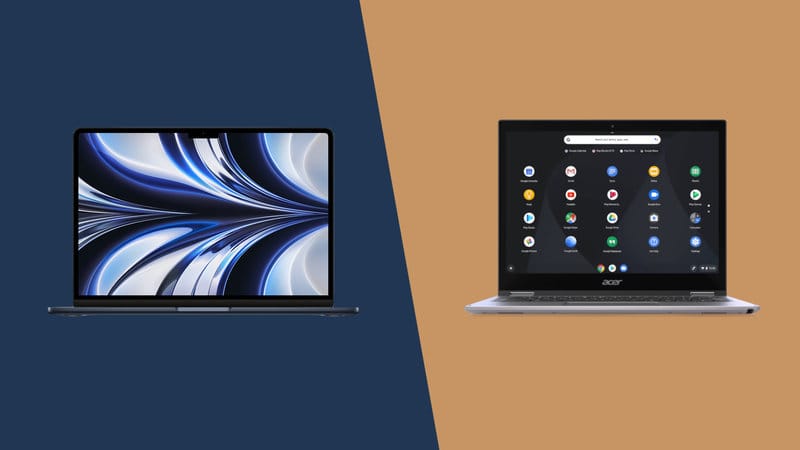Chromebook Vs. Macbook: Comparing OS For Different Use Cases

This article aims to provide an objective comparison of Chromebook and MacBook, focusing on the Chrome OS and macOS operating systems, respectively.
The comparison will be based on various factors such as design, user interface, performance and speed, app and software compatibility, storage and cloud integration, security and privacy, battery life and portability, price and value, as well as different use cases and target audience.
By analyzing these aspects, readers will gain insights into the strengths and weaknesses of both Chromebook and MacBook, allowing them to make informed decisions based on their specific needs and preferences.
It is important to note that this article adopts an academic style of writing, devoid of personal opinions or biases, in order to present an unbiased evaluation of these two popular computing options.
Design and User Interface
The design and user interface of both Chrome OS and macOS have been meticulously crafted to provide an intuitive and visually pleasing experience, catering to the diverse needs and preferences of users.
Chrome OS, developed by Google, offers a clean and minimalist design, with a focus on simplicity and ease of use. The interface features a taskbar at the bottom, providing quick access to frequently used apps and a launcher for easily locating and launching applications.
On the other hand, macOS, developed by Apple, boasts a sleek and sophisticated design, incorporating elegant animations and a consistent visual language. The interface includes a menu bar at the top, offering easy access to system settings and notifications.
Both operating systems prioritize user-friendly interfaces, ensuring a pleasant and efficient user experience.
Performance and Speed
When evaluating the performance and speed of these two operating systems, it is crucial to consider their capabilities and efficiencies.
Chrome OS, being a lightweight operating system, is known for its fast boot time and quick response. It is optimized for web-based tasks and can efficiently handle multiple tabs and web applications without significant lag.
On the other hand, macOS is a robust operating system that offers excellent performance for resource-intensive tasks such as graphic design, video editing, and software development. It provides a seamless user experience with smooth transitions and animations. Additionally, macOS benefits from the integration with Apple’s hardware, resulting in better performance and efficiency.
Ultimately, the choice between Chrome OS and macOS depends on the specific use case and the user’s requirements.
App and Software Compatibility
App and software compatibility between Chrome OS and macOS is an essential factor to consider, as it determines the extent to which users can seamlessly access and utilize a wide range of applications and programs on their respective operating systems.
Chrome OS, being primarily designed for web-based applications, relies heavily on the Chrome browser and Google Play Store for app availability. While it supports popular applications like Google Docs and Microsoft Office Online, it may lack support for certain specialized software used in professional settings.
On the other hand, macOS offers a wider range of software compatibility, especially for creative professionals, with applications like Adobe Creative Cloud and Final Cut Pro. Additionally, macOS supports virtualization, enabling users to run Windows or Linux applications.
In conclusion, while Chrome OS caters well to web-based applications, macOS provides a more diverse and comprehensive range of app and software compatibility.
Storage and Cloud Integration
This paragraph will discuss the storage and cloud integration capabilities of Chromebooks and MacBooks.
Chromebooks place a strong emphasis on cloud storage, with seamless integration with Google Drive. Users can easily store and access their files on the cloud, allowing for easy collaboration and accessibility across different devices.
On the other hand, MacBooks provide local storage options, allowing users to store their files directly on the device. Additionally, MacBooks offer iCloud integration, enabling users to sync their files across multiple Apple devices and access them from anywhere with an internet connection.
Chromebook’s emphasis on cloud storage and Google Drive integration
Chromebook provides seamless integration with Google Drive, offering users an efficient and convenient way to store and access their files in the cloud. Google Drive is a cloud storage service provided by Google, which allows users to store, share, and collaborate on documents, spreadsheets, and presentations.
With Chromebook’s emphasis on cloud storage and Google Drive integration, users can easily access their files from any device with an internet connection. This eliminates the need for physical storage devices and enables users to work on their files from anywhere. Additionally, Chromebook’s integration with Google Drive ensures that files are automatically saved and synced, providing a reliable backup solution.
The integration also allows for easy collaboration, as multiple users can work on the same document simultaneously and make real-time changes.
Overall, Chromebook’s emphasis on cloud storage and Google Drive integration offers users a convenient and efficient way to store, access, and collaborate on their files.
MacBook’s local storage options and iCloud integration
Moving on from Chromebook’s emphasis on cloud storage and Google Drive integration, let us now turn our attention to MacBook’s local storage options and iCloud integration.
Unlike Chromebooks, MacBooks offer a wide range of local storage capacities, ranging from 128GB to a whopping 8TB in some models. This allows users to store their files and applications directly on the device, providing a sense of security and accessibility even without an internet connection.
Additionally, macOS seamlessly integrates with iCloud, Apple’s cloud storage service, enabling users to effortlessly sync and access their files across multiple Apple devices. iCloud also offers features like automatic backup and file sharing, further enhancing the convenience and versatility of MacBook’s storage capabilities.
With its local storage options and iCloud integration, MacBook caters to users who prefer a blend of local and cloud-based storage solutions.
Security and Privacy
This discussion focuses on the security and privacy features of Chrome OS and macOS.
Chrome OS is known for its built-in security features, such as sandboxing, verified boot, and data encryption, which help protect against malware and unauthorized access. Additionally, Chrome OS provides automatic updates, ensuring that the system is always up to date with the latest security patches.
On the other hand, macOS offers robust security measures, including a built-in firewall, FileVault encryption, and Gatekeeper, which verifies the authenticity of downloaded applications. Furthermore, macOS provides users with a range of privacy controls, allowing them to manage their data and control app permissions.
Chrome OS’s built-in security features and automatic updates
Enhancing the overall user experience, Chrome OS boasts a robust security framework encompassing built-in security features and automatic updates.
Chromebooks are designed with security in mind, utilizing a sandboxing technique that isolates each application within its own environment, preventing malicious software from affecting other parts of the system. Additionally, Chrome OS employs verified boot, which ensures that the operating system has not been tampered with during startup. This feature provides users with a secure and reliable experience, as any unauthorized modifications are detected and resolved automatically.
Another key aspect of Chrome OS security is its automatic updates. Chromebooks receive regular updates that include the latest security patches, ensuring that users are protected against emerging threats. This proactive approach to security makes Chrome OS an attractive choice for individuals and organizations seeking a secure computing environment.
macOS’s robust security measures and privacy controls
Moving on from the discussion of Chrome OS’s security features, it is now imperative to delve into macOS’s robust security measures and privacy controls. Apple has long been recognized for its stringent approach to security, and macOS is no exception. With its built-in security features, macOS provides a highly secure environment for users.
Firstly, macOS includes Gatekeeper, which ensures that only trusted software from the App Store or identified developers can be installed.
Secondly, FileVault offers full-disk encryption, safeguarding data in case of theft or unauthorized access.
Lastly, macOS employs sandboxing, which isolates applications from one another, preventing potential malware from spreading.
Additionally, macOS provides users with extensive privacy controls, allowing them to manage app permissions and control access to sensitive data. These comprehensive security measures and privacy controls make macOS a reliable and secure operating system for users.
Battery Life and Portability
Battery life and portability are key factors to consider when comparing Chromebooks and Macbooks, as they significantly impact the user’s mobility and the device’s overall performance.
Chromebooks are known for their excellent battery life, often lasting up to 10 hours or more on a single charge. This is due to the lightweight nature of Chrome OS and the efficient hardware used in Chromebooks.
On the other hand, Macbooks also offer decent battery life, but it may vary depending on the model and usage.
Macbooks are generally more portable than Chromebooks, with sleek and lightweight designs that make them easy to carry around. However, some Chromebooks also come in compact sizes and are lightweight, making them equally portable.
Ultimately, the choice between a Chromebook and a Macbook depends on the user’s specific needs for battery life and portability.
Price and Value
Price and value are crucial factors to consider when evaluating the affordability and worth of Chromebooks and Macbooks, which can greatly influence the audience’s financial decisions and overall satisfaction with their purchase. Chromebooks are generally more affordable than Macbooks, making them a popular choice for budget-conscious consumers. However, it is important to note that Macbooks offer a higher level of quality and performance, which may justify their higher price tag for some users.
In terms of value, Chromebooks excel in providing a simple and streamlined experience for basic tasks such as web browsing and document editing. On the other hand, Macbooks offer a wider range of functionalities and software options, making them more suitable for creative professionals and power users. Ultimately, the decision between a Chromebook and a Macbook should be based on the individual’s specific needs and budget.
| Aspect | Chromebooks | Macbooks |
|---|---|---|
| Price | Generally lower cost | Higher cost |
| Performance | Basic tasks only | High performance |
| Software | Limited options | Wide range of options |
| Target audience | Budget-conscious users | Creative professionals and power users |
Use Cases and Target Audience
In terms of targeted user demographics, it is essential to consider the specific tasks and functionalities that each device offers.
Chromebooks are primarily designed for users who require a device for basic computing tasks such as web browsing, word processing, and media consumption. They are particularly suited for students, casual users, and those on a budget due to their affordability and streamlined operating system.
On the other hand, MacBooks are known for their powerful hardware, advanced software capabilities, and seamless integration within the Apple ecosystem. These devices cater to professionals, creatives, and individuals who require intensive tasks like video editing, graphic design, and programming. Their higher price point reflects the premium build quality and performance they offer.
Ultimately, the choice between a Chromebook and MacBook depends on the user’s specific needs and budget.
Frequently Asked Questions
Can a Chromebook run professional software like Adobe Photoshop or video editing software?
Yes, Chromebooks can run professional software like Adobe Photoshop or video editing software. However, the availability and functionality of these applications may vary as Chrome OS is primarily designed for web-based applications and relies on cloud storage and online editing tools.
Can a MacBook connect to a Google account and use Google services seamlessly?
Yes, a MacBook can seamlessly connect to a Google account and utilize Google services. This allows users to access their emails, documents, and other Google features through the macOS interface.
Are Chromebooks compatible with external devices like printers, scanners, or external hard drives?
Chromebooks are compatible with external devices like printers, scanners, and external hard drives. They can connect to these devices using USB ports or wirelessly, allowing users to easily access and utilize various peripherals for their needs.
Can a MacBook run Android apps and games from the Google Play Store?
Yes, MacBooks can run Android apps and games from the Google Play Store. This feature is made possible through software called BlueStacks, which allows users to emulate the Android operating system on their MacBooks.
Can a Chromebook be used for gaming, and does it have access to popular gaming platforms and titles?
Yes, a Chromebook can be used for gaming, but its gaming capabilities are limited compared to a Macbook. While Chromebooks have access to some popular gaming platforms and titles, they are primarily designed for web-based games and may not be able to run more demanding or resource-intensive games.







